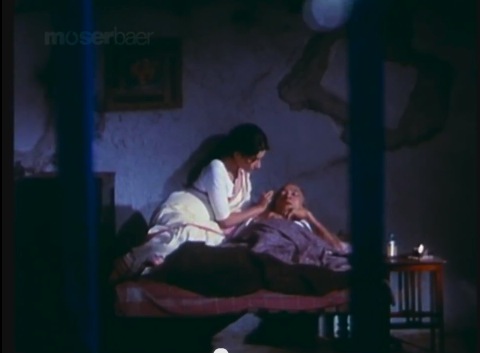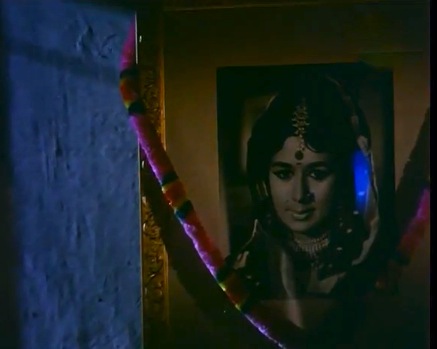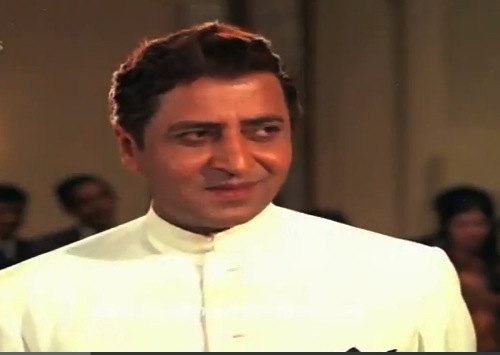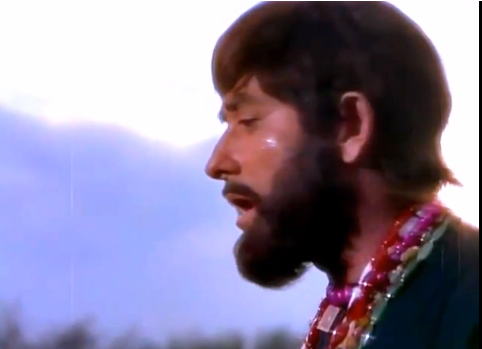
Scenes from classic Bollywood often make zero sense when taken out of context. In fact, much of classic Bollywood makes no sense even in context.
Bollywood is bursting at the seams with cliches. Do you remember your first old Bollywood film? Or worse, when you forced your previously uninitiated friend to watch a classic Hindi film with you? What about that game-changing moment when you realized you could predict the film’s outcome based solely on the simple fact that Lata Mangeshkar only sang for the real heroine and Asha Bhonsle always sang for the vamp?
We at Mr. and Mrs. 55 know how it goes. We understand the mass confusion that can ensue during a naive viewing party. The recovery can take years. You see, classic Bollywood movies have a secret language of their own. So we’ve put together a guide to old Bollywood films: a compilation of hidden signs, tricks, and cliches that make understanding any classic Hindi film WAY easier. Think of our list of 15 key cinematic tropes of Bollywood as a translation for what the director is really trying to tell you. Welcome to Classic Bollywood for Dummies.
1. A woman faints in the middle of a public gathering.

In her starring role as Mother India (1959), Nargis collapses after an agricultural celebration into a pile of hay. There can be only one explanation.
She’s pregnant. Is there a valid physiological explanation for this? Questionable. Did it happen to every single Indian woman who ever became pregnant in the 1950s-70s? Obviously. As far as the director is concerned, it sure beats filming an episode of morning sickness.
2. The camera pans from a couple making eyes at each other to the mountainside.

Mumtaz and Rajesh Khanna start to get uncomfortably close before the camera hurriedly pans away from the threatened PG moment in Aap Ki Kasam (1974).
Expect a baby soon. The scenic pan is one of the most classic tropes of Hindi cinema. When a camera pans away to nature’s beauty just before the money, it’s the director’s way of letting the audience know that everything we dreamed of happening is happening…only they can’t let you watch because of censorship law. The baby always shows up on cue a few scenes later . check out how it’s done in “Karvaten Badalte Rahe” from Aap Ki Kasam (1974).
3. If there are two (or three!) possible love interests, but only one is wearing traditional Indian clothes.

Framed by rural imagery with a white chunni billowing the wind, is it any surprise that corn-fed Nanda is the chosen one in Teen Devian (1965)?
He’s going to pick the more Indian one. Despite our hero’s love of the wild wild West, when it comes down to marrying someone he can proudly introduce to his mother, he picks the girl who consistently wears traditional Indian clothing. Equally ridiculous is the director’s oh-so-subtle hint that the film vamp has morally reformed when she at last dons a sari in place of her miniskirt.
4. The camera pans to a candle by the bed and the flame blows out.
Don’t expect that character to return in act II. I don’t know what it is about filming a death scene, that classic Bollywood actors and directors balked at the thought. They’ll usually cover you up until that very last breath–and then the camera will suddenly zoom-in on the candle by the bedside. When the candle blows out, it’s game over for our sick friend.
5. Fog enters the scene.
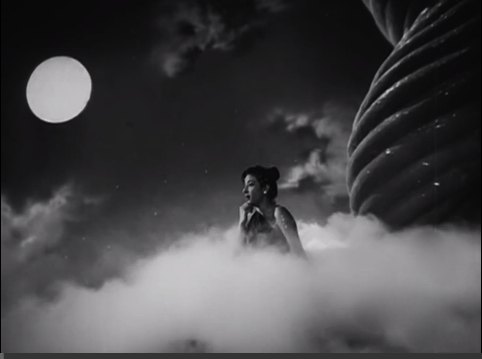
In a sequence famously choreographed by French artist Madame Simki, Nargis appears in the moonlight shrouded by fog in Awaara (1951).
There is a 50/50 chance this is all just a dream sequence. Fog indicates that this scene is taking place inside someone’s (or a collective) imagination, but may have never really happened. Song sequences are particularly notorious for this maneuver, portraying fantasies that are not congruent with everyone’s real relationships in the scene immediately following. Take everything you see enhanced by a fog machine with a generous grain of salt.
6. A woman’s sindoor gets smudged.

Nirupa Roy’s sindoor gets smudged in the opening sequence of Amar, Akbar, Anthony (1977). By the look on her face, it is clear she understands the cinematic implications.
Her husband is as good as dead now. The symbolism of the red sindoor (not to be confused with any old party bindi!) is well-understood by native audiences to denote that a woman is married. If you didn’t know that, and further didn’t know that the director likes to take artistic leaps of judgement, you would probably not understand the horrors of accidentally smearing your sindoor in a classic Bollywood film.
7. A male lead has distinctive shoeware.
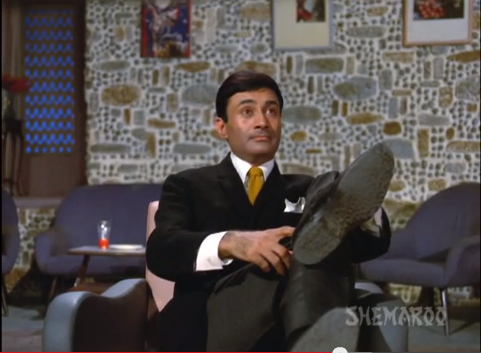
The integrity of Dev Anand’s feet is questioned in Jewel Thief (1967), demanding removal of his shoes at what is about to become a much more interesting house party.
He’s the secret villain. From having feet of two different sizes in Yaadon Ki Baarat (1973), missing toes in Jewel Thief (1967), or the white shoes of death in Humraaz (1967), footware has an important and sinister role in classic Bollywood. Beware the man who draws attention to his shoes. It may mean he has something hidden up his sleeve.
8. Someone’s photo suddenly has a garland around it and they’re nowhere to be seen.
That character is now dead. This subtle Indian custom has tricked many a naïve Bollywood viewer. Look specifically for a garland around the frame–it’s no mere decoration! A garland around someone’s photograph indicates that this beloved member of the troop has passed on to greater things. The director assumes you take this for granted as he does, so don’t let this prevent you from following the rest of the film, awaiting that character’s overdue return. “Ek Pyar Ka Nagma Hai” from Shor (1972) pulls the rug out from under our feet masterfully with this textbook trick.
9. When anyone goes to touch an elder’s feet and they try to stop them.

Nasir Hussain awkwardly attempts to block Asha Parekh from touching his feet in their first encounter in Kati Patang (1971). He will prove solid from this point on.
That elder is a good person. We can count on them. The custom generally goes that when someone younger meets or takes leave of an elder, he or she bows down and touches their feet out of respect. You’ll only rarely see this formality taken to completion because if the elder is a good guy, they try to block you halfway, as if to indicate that they are not worthy of such a show of deference. Of course, even the elaborate blockage itself is a formality, but both parties have to give it their best shot. And if the elder successfully intercepts the feet-touching, he or she is officially going to be your friend for life.
10. A miracle occurs. Mom gets her eyesight back after a freak accident, or the lover you thought was dead returns to life.

No matter what your faith, Rishi Kapoor proves devotion pays in Bollywood by divinely igniting the temple lamps using nothing more than his boyish good looks in Amar Akbar Anthony (1977).
Someone has recently prayed. I dare you to point out a Hindi film in which the hero or heroine prays and God doesn’t listen. Usually, the opening line goes something like this, “Bhagwan, main ne tujhe aaj tak kuch nahin manga.” [God, until today I have not asked you for anything.] You would think miracles were a dime a dozen in the ’70s.
11. The nightclub has white people in it.

Mumtaz dazzles her fan-base with grooves even the white folk can’t keep up with in Brahmachari (1968). How many can you count boosting the decor of this hep cat joint?
This is a really, really fancy joint. The director is trying to let you know that hero must be super cool and this place is really fashionable. You get extra points if there is a white woman in the heroine’s posse of girlfriends. I don’t like it either, but these are just the rules of the game.
12. A woman is dressed in all white and sings.

With sari white as snow, the mysterious femme fatale Sadhana creeps on Manoj Kumar in Woh Kaun Thi? (1964)
She might be dead. An all-white sari means she’s either a widow or dead, but you can narrow it down that if she’s singing a Lata song, she’s probably dead. The ghostly femme fatale is a hallmark of the Indian film noir genre.
13. Pran walks onto the set.
Despite his obvious game, Pran will never get the girl. So don’t be too worried. I don’t care if he’s the richest, the suavest, or even the best looking guy in the film. His matrimonial prospects are always foiled. On a related note, if you see “And…Pran!” flash at the end of the opening titles, you know the film is going to be good.
14. Lymphosarcoma of the intestine is diagnosed.
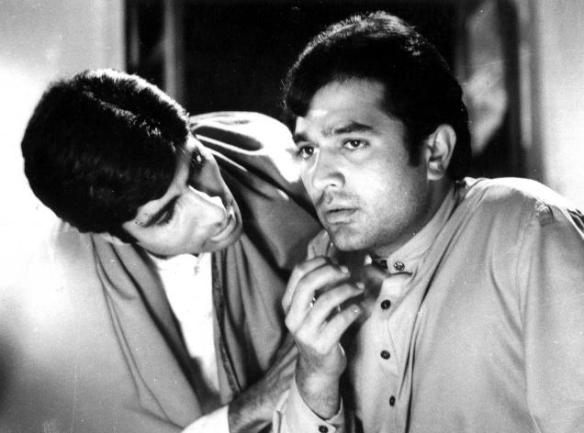
Amitabh Bachhan diagnoses Rajesh Khanna with the dreaded lymphosarcoma of the intestine, sealing his fate in Anand (1971).
They will die. Kiss this character goodbye right now for death is inevitable. We dedicated an entire post to this bizarre Bollywood trade secret.
15. The hero grows a beard.
Things have really gotten bad. Tragedy has hit a new low. Young Indian men who have no place among the clergy do not grow beards without a reason. In classic Bollywood, that logical reason is misfired love. Once you spot the hero shirking his daily man-scaping duties, his romantic prospects have hit rock bottom.
Feeling like you’ve been struck by lightening? Our all-inclusive Classic Bollywood for Dummies is the first step toward enlightenment! Did we miss a key clue to classic Bollywood films you wish you had known? Add to our list in the comments!
– Mrs. 55

